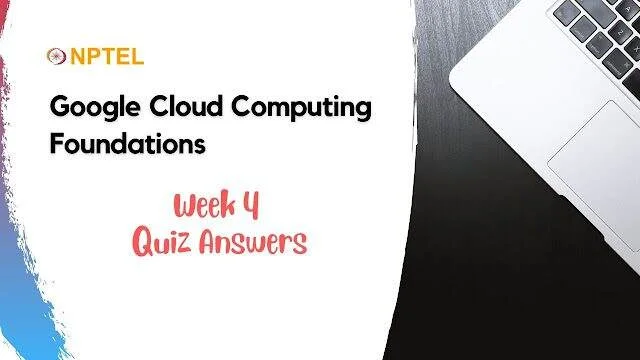Google Cloud Computing Foundations Week 4 Quiz Answer
In this article i am gone to share NPTEL Course: Google Cloud Computing Foundations Week 4 Quiz Answer with you..
Google Cloud Computing Foundations Week 4 Quiz Answer | NPTEL
Also visit: Google Cloud Computing Foundations Week 3 Quiz Answer
Week 4 Quiz Answer
Question 1) Which of the following is the most common API format in GCP?
- CLI
- gRPC
- REST
- SOAP
Question 2) What is the purpose of an API?
- APIs replace web pages.
- APIs create GUI interfaces
- APIs are non-HTTPS interfaces used to interface with web interfaces.
- APIs simplify the way disparate software resources communicate.
Question 3) Which of the following is the protocol used by REST APIs?
- HTTPS
- RDP
- ICMP
- Telnet
Question 4) True or False. Firebase Authentication and Auth0 are two of the utilities Cloud Endpoints uses to support service-to-service and user authentication.
- True
- False
Question 5) You are looking for a managed API service to provide an API frontend to your legacy systems. Which of these services would meet your needs?
- CLI
- gRPC
- Cloud Endpoints
- Apigee Edge
Question 6) What are the specifications that Cloud Endpoints supports?
- CLI
- RFC
- IEEE
- OpenAPI
- gRPC
Question 7) You are looking for a managed API service for your cloud-based services? Which of these services would meet your needs?
- CLI
- False
- Apigee Edge
- Cloud Endpoints
Question 8) How does Cloud Pub/Sub deliver messages to endpoints?
- Through an internal ID.
- Through a publish/subscribe pattern
- Messages have to be pulled by the front end.
- By pushing messages to all available endpoints based on an internal list.
Question 9) What are the types of message delivery supported with Cloud Pub/Sub?
- Pull
- Poll
- Push
- Bounce
Question 10) You need a simple and reliable staging location for your event data on its journey towards processing, storage, and analysis. Which one of the following services should you consider?
- Apigee Edge
- Cloud Dataflow
- Cloud Endpoints
- Cloud Pub/Sub
Question 11) Which statement regarding GCP and data encryption is accurate?
- Only data at rest is encrypted.
- Only data in transit is encrypted.
- Data is encrypted at rest and in transit.
- Nothing is encrypted by default. Data must be encrypted by the customer.
Question 12) True or False. Managing GCP users through Google Groups allows an administrator to manage team identities centrally
- True
- False
Question 13) When comparing on-premises, IaaS, PaaS, and managed services, which option requires the least amount of work for the user in terms of security?
- IaaS
- PaaS
- Managed service
- On-premises
Question 14) Which of the following is the correct statement for a service account in GCP?
- Lock down a user.
- Create a user in GCP.
- Give permissions to a group of users.
- Allow for service-to-service interaction with GCP.
Question 17) What do primitive roles grant permissions to?
- Folders
- Resources
- Projects
- Organizations
Question 16) Which of the following is not an example of a primitive role?
- Owner
- Admin
- Viewer
- Editor
Question 17) When setting up user/role pairings in GCP, which of the following is true?
- Permissions are not inherited.
- Everyone is a project owner by default.
- Permissions are inherited and the least restrictive permission will be inherited
- The user will always inherit the stricter permission applied
Question 18) What service is used to supply encryption keys when users want to manage their own keys?
- CloudHSM
- Cloud Key Management System
- Google is encrypted by default. No keys are required
- The customer must bring their own keys and manage them
Question 19) There are a number of best practices that should be applied to identity and access management. Which of the following does Google recommend?
- Use folders to group instances
- Use custom roles for all objects
- Try to use primitive roles instead of pre-defined roles
- Use the “principle of least privilege” when distributing permissions
Question 20) True or False. Cloud Identity-Aware Proxy (Cloud IAP) allows you to use an application-level access control model instead of relying on network-level firewalls
- True
- False

